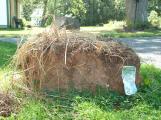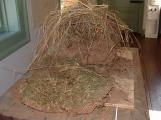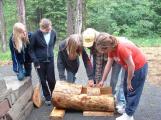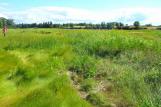113
Jim Reeves and Brett Nuttall looking at drainage end of replica aboiteau24 August 2010
Wallace and Area Museum, Davison /Kennedy property
 Credits:
Credits:Jessica Jamieson
114
A block of marsh sod showing one half metre root length; twenty dollar bill gives some perspective24 August 2010
Tuttle Creek, Wallace Bridge, Cumberland County, Nova Scotia.
 Credits:
Credits:David Dewar
115
Barbara Clark, volunteer artist for the Museum's Heritage Murals21st century
Wallace and Area Museum, Davison /Kennedy property
 Credits:
Credits:Charlotte Moody
116
Barbara Clarke on top of her painting21st century, May 2010
Wallace and Area Museum, Davison /Kennedy property
 Credits:
Credits:David Dewar
117
Research of local Acadian history, printed by Tatamagouche amature historian Roy Kennedy20th Century, Circa. 1982
Nova Scotia
 Credits:
Credits:Roy Kennedy
118
Marsh sod with heavy root structure in background and lawn sod with smaller roots in foreground24 August 2010
Tuttle Creek, Wallace Bridge, Cumberland County, Nova Scotia.

119
Encompassed land behind Akerly Brook Dyke18th Century, Circa 1730
Akerly Brook, Wallace Bay, Cumberland County, Nova Scotia
 Credits:
Credits:David Dewar
120
Dewar River facing south during spring floods18th Century, Circa 1720
Dewar River, Malagash, Cumberland County, Nova Scotia.
 Credits:
Credits:David Dewar
121
Map of Nova Scotia drawn by Surveyor General Charles Morris in 175518th Century, 1755
 Credits:
Credits:David Dewar
122
Jim Reeves measures site of small aboiteau still in place after nearly 300 years18th Century, Circa. 1720
Dewar River, Malagash, Cumberland County, Nova Scotia.
 Credits:
Credits:Charlotte Moody
123
Jim Reeves shows school students how an aboiteau works and how they were built21st Century. Circa June 2005
Wallace and Area Museum, Davison /Kennedy property
 Credits:
Credits:Charlotte Moody
124
Dyke Along Tuttle Creek18th Century, Circa 1730
Tuttle Creek, Wallace Bridge, Cumberland County, Nova Scotia.
 Credits:
Credits:David Dewar
125
The Dykes of Remsheg Bay18th Century, Circa 1720
Remsheg, one of 19 ways to spell the Mi'kmaq name for the village in Nova Scotia now Wallace
July 11, 1764, it was legal for the Acadians to return if they were willing to take an unqualified oath of allegiance.
The Dykes of Remsheg Bay
By: Francis Grant
In seventeen hundred and ten they'd come
Into primal forest land,
Then raised their dwellings, log on log
And roofs contrived, with adept hand'
Of poles, and bark from ancient birch;
Built chimneys, stout, of stone and clay;
And that their flocks and their herds be fed,
They raised the Dykes of Remsheg Bay
The men-folk shaped with axe and saw,
Bed, board and bench; their wants were small;
With skillful knife, carved bowl and spoon
And for the toddler's dog and doll:
The cradle by the hearthside stood
And lulled by many an ancient lay
Babe after babe was rocked within,
Born by the dykes of Remsheg Bay.
The women helped to shear the sheep,
Then washed the wool till snowy white
They carded, spun and wound the yarn
By fire and tallow-candle light:
They knit and wove the family clothes,
With song and myth of work made play;
They dyed their garments brilliant hues,
Near-by the dykes of Remsheg Bay.
The Children many tasks performed;
They watched the sheep and pulled the weeds,
Picked berries, red and blue and black,
In great abundance for their needs;
They loved the early weeks of spring,
When maple sap flowed day by day,
And reveled in the toothsome sweets,
Made by the dykes of Remsheg Bay.
In winter furs were worn for warmth,
Of fox and beaver, bear and moose,
Of muskrat, otter and raccoon,
And feathers from the migrant goose
Were prized by householder for the beds,
With well filled ticks whereon to lay,
In comfort cold and frosty nights'
By ice bound dykes of Remsheg Bay.
The earliest settlers had no school,
The Priest alone could write and read,
They farmed and fished and hunted game,
Of learning had but little need:
Acadian people liked to dance,
To tell old legends, sing and play,
And many a fiddler's lively tune
Rang o'er the dykes of Remsheg Bay.
Four decades and a half they lived
On Remsheg shores, and prospered well
By shipping food to Louisburg,
A practice Britian sought to quell,
But greedy for the French King's gold
Continued in their stubborn way
To send their kine, grown fat upon
Lush grass by dykes of Remsheg Bay
Shrewd Governor Lawrence saw that war
Would soon break our with sword and gun,
And off to England letters sent,
Suggesting what should now be done,
As threats to Nova Scotia loomed
Acadians must be shipped away,
From every hamlet in the land,
Including chose at Remsheg Bay
Swift sailing frigates of the fleet
The orders carried overseas,
But ships of sail are subject to
The wind and weather vagaries;
Time sped away and fall drew near,
No longer could there be delay
At ease they laboured on their farms
Beside the dykes of Remsheg Bay.
And so it was that Lawrence, then
With neighboring Governor Shirley's aid,
Moved forward on expulsion plans-
The dire and dread decision made:
Ere the reply had been received,
Which ordered an emphatic , "Nay! "
New England soldiers had arrived
At Tatamagouche and Remsheg Bay
The Massachusetts troops abhoored
This task they were compelled to do
But orders soldier must obey
Good Captain Willard sickened too,
As homes and barns went up in flames,
Lifetime hard labor wrenched away,
While men stood prisoners women wept.
At Tatamagouche and Remsheg Bay
With bright and pleasant cloudless skies,
August fifteenth had thus begun,
And lazy fragrant wood- fire smoke
Climbed slowly towards the smiling sun;
By nightfall how the scene had changed!
Sad hearts were leaden, skies were grey;
The first to feel the awesome blow
Were Tatamagouche and Remsheg Bay.
Two centuries and more have passed,
Almost unknown their doleful tale;
Alone the toil wrought dykes remain,
No other trace o'er hill and dale
But year on year the mounds stand forth,
"We mourn our loss," they seem to say,
And marsh winds add their haunting wail,
Along the dykes of Remsheg Bay.
Credits:Francis Grant
126
Rich marshland in Tatamagouche Bay18th Century Circa 1710
Dewar River, Malagash, Cumberland County, Nova Scotia.
 Credits:
Credits:Jim Reeves
Brett Nuttall